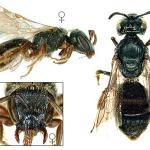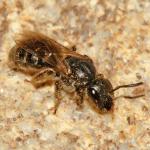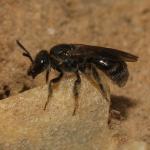Hylaeus punctatissimus Schenck, 1853, Hylaeus flavitarsis Schenck, 1853, Halictus similimus Schenck, 1870, Halictus porcus Morawitz, 1872, Halictus griscescens Schenck, 1873, Halictus longiceps Saunders, 1879, Halictus trinitinensis Cockerell, 1938, Halictus angustifrons Vachal, 1892, Halictus rubescens Pérez, 1895
England from Cornwall to Kent, north to Cumberland and Yorkshire, Wales and the Isle of Man. Also known from south-west Scotland. It also occurs on several of the Channel Islands. Most frequent in southern England.
Abroad, this is a western Palaearctic species, to Iran in the east and north to Finland.
This species is not regarded as being scarce or threatened.
Found in open coppice, sandy areas and coastal soft rock cliffs.
The female flies from mid-March to late September, the male from July (possibly June) to September.
A mining bee, probably solitary. The nesting biology is not known, suggesting that the nests may be well dispersed and hard to locate.
The females are found mainly on Lamiaceae, males will also visit flowers of a wide variety
of other plant families.
Sphecodes crassus has been recorded as a cleptoparasite (Westrich, 1989).
2012




